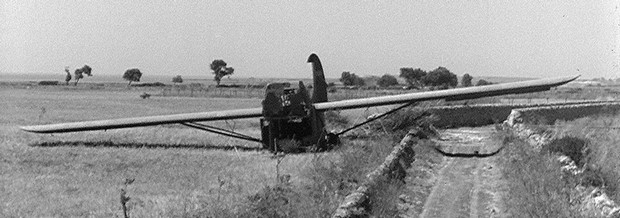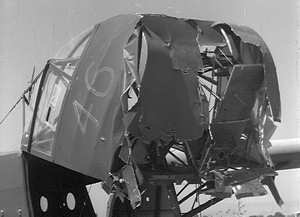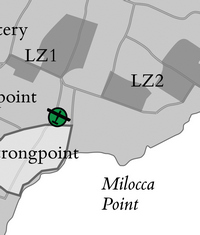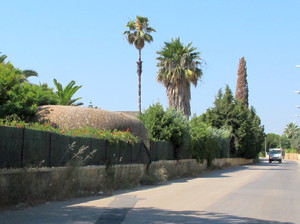Glider 46 landed in a hornets’ nest of Italian defences. For good measure it kicked the nest first by trying to land on the roof of a pillbox.

Glider: CG-4A Waco 46, serial 246587.
Glider carrying: 9 Subsection, 3 Section, 9th Field Company Royal Engineers.
Troops’ objectives: To support the 2 South Staffords at the gun battery Mosquito or the Ponte Grande & Putney bridges (for a guide to the objectives, see [here]).
Manifest
Sec Offr
11 ORs
= 2400 lbs
1 h/c. 600 lbs
2 bicycles. 70 lbs
No. 18 Set. 280 lbs
Capt Holmes, J H
Cpl Pink, H
L/Cpl Raggett, L
Spr Thomson, W
Spr Cook, J
Spr Moss, M
Spr Todd, N
Spr Pedan, J
Pte Churcher, R C
Spr Hillman, J
Spr Sibley, J
Spr Henderson, J
Holmes was second in command of 9 FCRE, and deputy to its CO Major Beazley. He was in charge of the engineers that had been allotted to support the 2 South Staffords in capturing and neutralising their objectives. A second detachment was allocated to the men of 1 Border.
Glider Pilot’s Report
Glider allotted Landing Zone: LZ 1 [map].
First Glider Pilot: Sgt Dyer
Second Glider Pilot: Sgt Maddocks
“Very good tow, fairly constant speed, too close formation to release pt. Over MALTA tow plane crossed rope of leading combination. Glider released at 2235 hrs, at 2,000 ft, approx 2,000 yds off coast and made successful landing 3-400 yds short of correct L.Z. Undercarriage damaged.”
In terms of position, Glider 46 did indeed make a good landing not far from the edge of LZ 1 [map].
However a later examination revealed that the glider had hit an Italian pillbox as it landed. The chances of that happening must have been infinitesimally small, given the size of the area around the LZs and the comparative rarity of pillboxes:
“Landed parallel to stone wall and struck top of pill box that protruded from wall. Landing gear washed off on pill box and under portion of nose slightly damaged. Wing struts slightly bent from landing gear.”
It’s not clear from photographic evidence exactly where this pillbox was. Glider 46 ended up just over 100 yards north of the barbed wire entanglements protecting a major Italian strongpoint based around the farm Masseria Palma [map]. Intelligence maps showed a pillbox not far behind the wire. A Waco’s landing flight was long and shallow, so perhaps Glider 46 hit the top of that pillbox and coasted on to a skidding landing nearly 200 yards away.
Tug Pilot’s Report
Tug: C-47, 41-38705, Nose (Sqn) No. 78, 28 Squadron, 60 Troop Carrier Group, 51 Troop Carrier Wing USAAF. second aircraft in element 5.
Takeoff: Between 18:48 and 19:15 hrs, from Airstrip B, El Djem No. 1 [map], Tunisia.
Pilot: 1st Lt Moore, Homer L
Co-pilot: 1st Lt Snyder, Robert H
Air Engr: S/Sgt Blanton, James
Rad Oper: Pfc Semovic, George (NMI)
“Hit Rel Point?: Yes
Time of Release: 2234
Altitude: 1850
Vary from Course: No
Winds caused correction. Searchlights and AAA fire on point de Milocca. Could not get identification for homing. Scattered clouds along route.”
Action
The war diary of 9 FCRE reported:
“Company H.Q. consisted of Major B.S. Beazley R.E. and driver who travelled with the 2nd S/Staffords under whose command was Captain J.N. Holmes R.E. and No. 3 Section [in Glider 46]. Their role included the destruction of a coastal battery [Mosquito], dismantling charges in [Waterloo and Putney bridges] and establishing a water point for the Brigade as an extreme shortage of water was expected. […]
The landing about 2330 hours did not go according to plan. Gliders were very dispersed only three of the Company’s eight arriving anywhere near their Landing Zone. The result was that instead of the ensuing battle being a co-ordinated Brigade effort, it turned into innumerable small fights, the Commanders of the Glider Loads attempting to reach their Company objectives. The only Sapper to reach his objective in time to be effective was the O.C. [Major Beazley]. He reached the [Ponte Grande] bridge six hours after landing and removed the charges.
The remainder fought by themselves and with the infantry making for the road bridge which was reached by most Sapper Gliders loads on the evening of the 10th., when they were relieved by the 8th. Army. “
Capt Holmes, senior officer in Glider 46, left a more detailed account:
‘This glider landed about 1000 yards S of the centre of the L.Z. It came under fire from two M.Gs straight away, and consequently, attempts to unload the hand-cart were stopped.”
Glider 46 had unfortunately landed in the middle of a hornet’s nest of several Italian defence posts. Not just landed in it, but kicked it first by striking a pillbox. That pillbox was behind it. Another pillbox also forming part of the Masseria Palma strongpoint was less than 350 yards to its right [photo][map], while an Italian garrison held the farm at Casa Gallo [map], some 300 yards to its left.
Holmes continued:
“The S/S [subsection] moved north towards the concentration area. It again came under rather erratic fire, and it was decided to lie up and keep a watch for some of our own men. No one had appeared by dawn so we again went north for the coasts, but struck an enemy patrol. I decided to disengage, but in doing so the rifle and Bren groups became separated. However, the two separated parties continued towards “Waterloo” [the Ponte Grande bridge], lying up for considerable periods due to enemy activity. One party with myself finally joined up with Lt. O’Callaghan and his men, and arrived at “Waterloo” at 1700 hrs. The other party came in by itself at 2000 hrs to “Walsall”.’
Holmes’ arrival at the Ponte Grande was slightly more exciting than he gives himself credit for. Lt O’Callaghan, another 9 FCRE officer, has the story. He had landed with a platoon of South Staffords in Horsa glider 135. After several fights they reached the area of Walsall [map], south of the Ponte Grande. O’Callaghan wrote:
“Capt Foot of the South Staffs [Glider 5] and 10 S/Section [9 FCRE Glider X] joined us here. After a rest of about an hour we decided that the bridge must be in enemy hands and decided to re-take it. As we were moving up to the bridge I met Capt. Holmes and a few Sappers from 9/S/Section who joined in the party. We had almost reached the bridge when a number of Bren Carriers of the 8th. Army moved on to the bridge and captured it.”
If correct, this means that Foot’s party must have finally numbered about 60 glider troops, a sizeable force by Operation Ladbroke standards, and almost as many as had held the bridge for most of the day against the Italians.




No mention of Major Beazley being killed. Is this covered elsewhere?
I am interested. My father was in glider 46.
I am also interested to know more about the 9th RE destroying a railway line to prevent the enemy using it to re-inforce .
Thanks Norman. There is a lot about Beazley in the Boucher-Giles and Stokes accounts on ‘The Story of Glider 110’ page. I’m not aware of any 9 FCRE op in Operation Ladbroke to destroy railway lines – where did you read about it?
Thanks Ian. Read the Glider 110. My father told me he and others went down the coast by boat and set explosives at different sections of a railway line and blew it up. He told me the type of explosive but cannot remember the name.
Thanks Norman. The operation your father mentioned was not part of Operation Ladbroke, which was limited to 9th and 10th July. I’m not an expert on what happened to 9 FCRE after that.